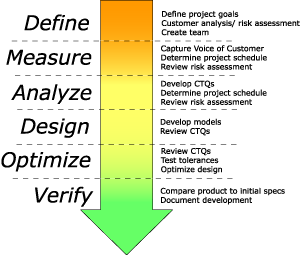Design of Experiment (DoE) is a structured, organized method that is used to determine the relationship between the different factors (Xs) affecting a process and the output of that process (Y). This method was first developed in the 1920s and 1930, by Sir Ronald A. Fisher, the renowned mathematician and geneticist.
Design of Experiment involves designing a set of ten to twenty experiments, in which all relevant factors are varied systematically. When the results of these experiments are analyzed, they help to identify optimal conditions, the factors that most influence the results, and those that do not, as well as details such as the existence of interactions and synergies between factors.
DoE methods require well-structured data matrices. When applied to a well-structured matrix, analysis of variance delivers accurate results, even when the matrix that is analyzed is quite small. Today, Fisher's methods of design and analysis are international standards in business and applied science.
Experimental design is a strategy to gather empirical knowledge, i.e. knowledge based on the analysis of experimental data and not on theoretical models. It can be applied whenever you intend to investigate a phenomenon in order to gain understanding or improve performance.
Building a design means, carefully choosing a small number of experiments that are to be performed under controlled conditions. There are four interrelated steps in building a design:
1. Define an objective to the investigation, e.g. better understand or sort out important variables or find optimum.
2. Define the variables that will be controlled during the experiment (design variables), and their levels or ranges of variation.
3. Define the variables that will be measured to describe the outcome of the experimental runs (response variables), and examine their precision.
4. Among the available standard designs, choose the one that is compatible with the objective, number of design variables and precision of measurements, and has a reasonable cost.
Standard designs are well-known classes of experimental designs. They can be generated automatically as soon as you have decided on the objective, the number and nature of design variables, the nature of the responses and the number of experimental runs you can afford. Generating such a design will provide you with a list of all experiments you must perform, to gather enough information for your purposes.
Design of Experiments (DoE) is widely used in research and development, where a large proportion of the resources go towards solving optimization problems. The key to minimizing optimization costs is to conduct as few experiments as possible. DoE requires only a small set of experiments and thus helps to reduce costs
Design of Experiment involves designing a set of ten to twenty experiments, in which all relevant factors are varied systematically. When the results of these experiments are analyzed, they help to identify optimal conditions, the factors that most influence the results, and those that do not, as well as details such as the existence of interactions and synergies between factors.
DoE methods require well-structured data matrices. When applied to a well-structured matrix, analysis of variance delivers accurate results, even when the matrix that is analyzed is quite small. Today, Fisher's methods of design and analysis are international standards in business and applied science.
Experimental design is a strategy to gather empirical knowledge, i.e. knowledge based on the analysis of experimental data and not on theoretical models. It can be applied whenever you intend to investigate a phenomenon in order to gain understanding or improve performance.
Building a design means, carefully choosing a small number of experiments that are to be performed under controlled conditions. There are four interrelated steps in building a design:
1. Define an objective to the investigation, e.g. better understand or sort out important variables or find optimum.
2. Define the variables that will be controlled during the experiment (design variables), and their levels or ranges of variation.
3. Define the variables that will be measured to describe the outcome of the experimental runs (response variables), and examine their precision.
4. Among the available standard designs, choose the one that is compatible with the objective, number of design variables and precision of measurements, and has a reasonable cost.
Standard designs are well-known classes of experimental designs. They can be generated automatically as soon as you have decided on the objective, the number and nature of design variables, the nature of the responses and the number of experimental runs you can afford. Generating such a design will provide you with a list of all experiments you must perform, to gather enough information for your purposes.
Design of Experiments (DoE) is widely used in research and development, where a large proportion of the resources go towards solving optimization problems. The key to minimizing optimization costs is to conduct as few experiments as possible. DoE requires only a small set of experiments and thus helps to reduce costs



